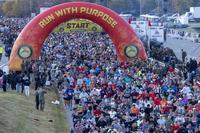This favorite workout of the week is designed for someone looking to build strength, but also maintain muscle stamina and cardio endurance. Having a foundation of strength can help tactical athletes be more durable under heavy rucks, equipment carries, and other impactful and load-bearing activities.
This is not a normal strength plan, as tactical athletes are not your normal athletes. In this program, you also need to focus on other elements of fitness, such as muscle stamina and endurance during running, rucking and/or swimming.
Warm-up
This warm-up includes air squats, Romanian deadlifts (RDL) with kettlebells (KB), and a run pyramid 1-10 with 50-meter runs in-between. It looks like this:
- 1 squat, 1 KB RDL, jog 2 x 25 meters
- 2 squats, 2 KB RDL, jog 2 x 25 meters
- 3 squats, 3 KB RDL, jog 2 x 25 meters
- Keep up to level 10, slowly increasing the speed of later shuttle runs as desired.
- Stop at 10 squats, 10 KB RDL.
If you prefer not to do weighted RDLs, do a toe touch instead that uses a form similar to deadlifting (Straight back/hip hinge).
If you feel like you need a little more warm-up for the legs and back, consider using an elliptical, bike or rowing machine for 5-10 minutes to get the body heat up and you primed for lifting the following exercises.
Work/Strength Section
The following lifts focus primarily on the legs and back. If you do not like doing deadlifts and squats on the same day, consider bumping the deadlift exercises to the day when you do pull-ups. Another option is to go heavy with a barbell on the deadlift and focus on lighter kettlebells or barbells for deep, slow (but lightweight) squats.
Repeat four times.
- Deadlift 5
- Hanging knee-ups 20*
* It is up to you if you want to add a set of hanging knee-ups as your rest, but it is a good in-between set of active rest that stretches out the torso after lifting a moderately heavy weight off the floor.
Repeat four times.
- Squats 10
- Walk, jog or bike for two minutes easy
Muscle Stamina Section
Walking lunges carrying a 25- to 50-pound sandbag is not easy for long distances. If 200 meters is too long, back it to 50-100 meters and build it up to this distance if you are new to lunging to this volume level. We typically build up to 400 meters of lunging with sandbags over the lifting cycle, but you can start this process without weight and see how you handle it.
Sandbag lunges 200 meters: Carry a sandbag on your arms and against your torso as this will simulate walking lunges with a log in future training if that is a route you seek.
Cardio Section
Run/ruck or swim (or both): If you have time, add some extra cardio, mainly as a cooldown and maintenance for your endurance. If scheduling is an issue, this section can be broken into a second workout done later in the day. Depending on your future training or desired cardio activity, take a pick between running, rucking or swimming with fins.
Run or ruck three miles: If you run, try a negative split workout of jogging 1.5 miles. Then in the back half of the three-mile run, try to beat the time that it took to run the first 1.5 miles.
Swim 2,000 meters with fins: If the pool is available, enjoy a swim for 30-40 minutes to see whether you can achieve this distance in that time, using a mix of the side stroke, freestyle and turtleback with scuba fins on your feet.
Optional Cooldown
Walk or tread water for 10 minutes, followed by a light five-minute stretch and five-minute massage or foam roll.
This is a rather advanced workout that many of our local special operations candidates consider a leg day. With some adjustments, you can modify it to fit your abilities and goals, and enjoy a routine that works the strength and muscle stamina in the legs and core, and a cardio workout that pushes the legs and lungs as desired.
Stew Smith is a former Navy SEAL and fitness author certified as a Strength and Conditioning Specialist (CSCS) with the National Strength and Conditioning Association. Visit his Fitness eBook store if you're looking to start a workout program to create a healthy lifestyle. Send your fitness questions to stew@stewsmith.com.
Want to Learn More About Military Life?
Whether you're thinking of joining the military, looking for fitness and basic training tips, or keeping up with military life and benefits, Military.com has you covered. Subscribe to Military.com to have military news, updates and resources delivered directly to your inbox.



















